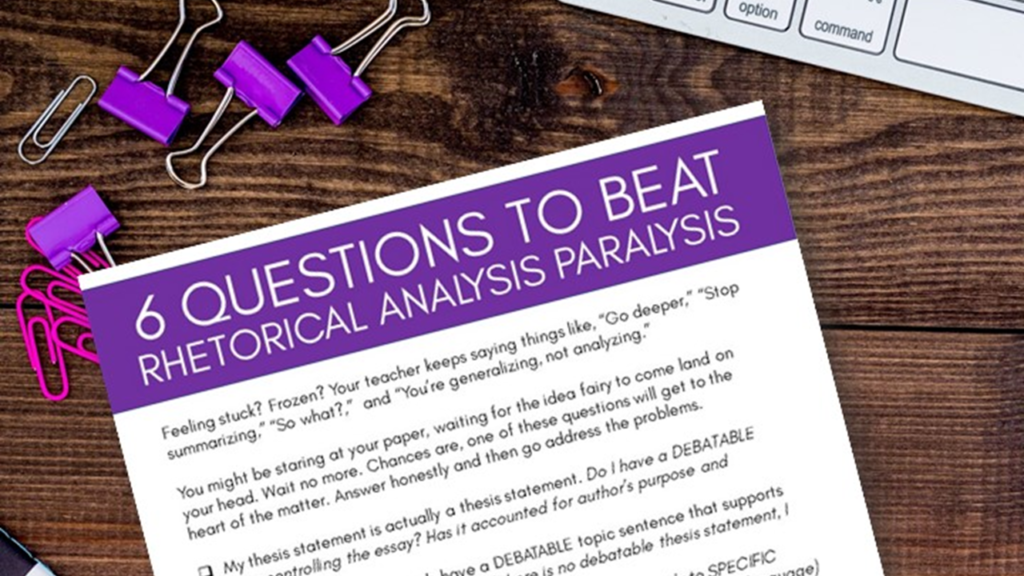
Argument gets attention, and synthesis gets a visit, but we all know that rhetorical analysis is where students tend to struggle, both with confidence and skills, while getting ready for the AP Language exam.
Tip #1: Get Creative with Anchor Charts
Have students create their own four-page anchor charts. Each one should include tone words in categories, device terminology, rhetorical strategies, the rhetorical triangle, SOAPS or the acronym of your choice, etc. If you’re already pressed for time or pulling this task off remotely is just more of a headache than you want right now, I have a version already done up for you. It’s print ready and linked to Google Slides as well.

Tip #2: Gamify the Planning
If you’ve been on any of my webinars or taken my course on building confident writers, you know that I’m all about the thesis and topic sentences having teeth. If there’s no debate—even in rhetorical analysis—the students will hit a brick wall with commentary. The trick is that they have to develop the debate quickly, and that’s where the game comes in. If you’re face-to-face with your students, post six prompts around the room and give each student something like this template:

On this gallery walk, they move from prompt to prompt, read, and fill in the template. You could time them, use a hole punch on a piece of card stock for every one they turn in, put them in teams of two or three for the rotations, and play jazz in the background. Add a layer of fun by disallowing conversation. Let each student carry around a categorized tone list and a couple of sticky notes. If students work in teams, they have to use their sticky notes and tone lists to identify shifts in tone without talking.
A not-quite-as-fun version of this exercise could be done remotely with breakout rooms, but it might work best as a whole-group activity during which all students are working on the same prompt.
Tip #3: Circle the Wagons
A different version of the gallery walk would be a circle of six desks. Students deal with one prompt and pass it to the left. Shake it up by stopping the process and requiring that the person to the left not only fill out the template but then attempt to write topic sentences based on the thesis of the person to the right.
Tip #4: Deal with Analysis Paralysis
I love the “Ask three then me” thing that elementary teachers have going on to prevent 25 little ones from climbing all over them to ask questions. The high school version of that for me is 6 Questions to Beat Analysis Paralysis. It’s just a one-page guide for students to use while they’re waiting for me during one-on-one writing conferences. If they can get themselves unstuck, I’m all about it. You can grab that sheet here. It would work well as a review tool as well. (Warning: Study it before you distribute it. At this point (late April), if you have not taught students that topic sentences must be debatable, this sheet may do more harm than good. Make sure it won’t cause confusion before you go crazy telling students to follow it to the letter.)

Tip #5: Have a Candid Conversation
Process with students the reality that a conclusion for a timed rhetorical analysis is a low, low priority. If your students are taking the digital version of the exam this year, the RA question will be the third prompt, as in the LAST of the three free-response prompts, as in the LAST thing they do when their brains are MUSH. They will have plowed through an hour of multiple choice and two essays before they get to what is arguably the most challenging part of the exam. Don’t tell anybody I said this, but I think at that point, if they can string together several words of the English language into a thesis statement that can earn the point, they can let go of the rest of that lovely yet fairly pointless intro as well.
Here’s my rule of thumb I give students for the paper-pencil exam: Do the hardest question first when you still have some brain. Do the “easiest” one last. For a lot of my students, that puts the question order at 2-1-3.
If your students find themselves with copious amounts of time going the RA prompt, tell them to write the intro and conclusion. Knock yourself out, but if pressed for time, it’s thesis and go.

